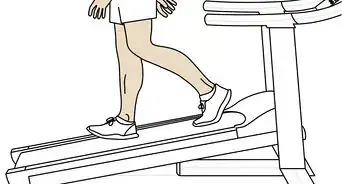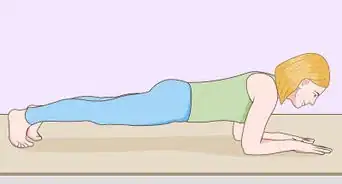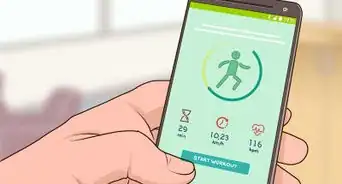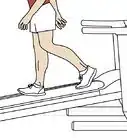This article was co-authored by Souad Gharib. Souad Gharib is the Founder of Female Trainer, a boutique women's gym based in West London, United Kingdom. Souad specializes in helping women reach their goals through exercise, nutrition, and counseling. Female Trainer offers personalized training sessions delivered by Souad and her experienced team of female trainers.
There are 10 references cited in this article, which can be found at the bottom of the page.
This article has been viewed 70,510 times.
When you’re a teen with a busy schedule, it can be difficult to find time to be active. But making time to stay active after and even during school hours is important for your health. Physical activity can help you avoid obesity, manage anxiety, and build a strong immune system. Learning to be active as a teen will also help you remain active as an adult. By committing to activities that make you happy, you’ll be able to make your after-school time healthy and even fun.
Steps
Joining an After-School Sports Team
-
1Play a sport that you enjoy. You can find sports offerings at your school, local community centers, and institutions dedicated to specific activities. There are lots of sports teams open to students with different levels of talent. You don’t need to be a star athlete to try out, and practicing with the team will develop your skills. These activities will not only allow you to enjoy some healthy competition, they’ll also keep you fit![1] [2]
- While your coaches will want you to strive for excellence, try not to worry too much about winning. Instead, focus on the fun you can have being on a team with friends, and the health benefits you’re getting from the activity.
- Consider trying one or several popular sports usually offered at schools, including football, soccer, baseball, softball, basketball, tennis, field hockey, or lacrosse.
- For lesser-known alternatives that may or may not be offered at school, try sports such as dance, figure skating, rock climbing, horseback riding, golf, skateboarding, roller skating, fencing, and rowing.[3]
-
2Practice your chosen sport if you don’t make the team. If your school is especially passionate about having a winning team for a particular sport, they may be more selective with their players. It might be difficult to be chosen even for their freshmen and junior varsity teams. If you want to play this sport, however, don’t give up! Play on your own, ask friends who are on the team to help you get better, and ask the coach if you can observe team practices.
- Go online and research your sport to learn drills and exercises that will help improve your performance at try-outs next time.
- If you want to play basketball, for example, practice drills that focus on improving agility and eye-hand coordination.
Advertisement -
3Participate in an after-school team at a community center. You may not want to play a sport at your school. Maybe excessive school spirit isn’t your thing, or you don’t want to do tryouts. Many local community centers will have more informal team-sports offerings that could introduce you to a new set of friends while helping you stay active.
- Community centers may offer sports that schools generally don’t provide, including kickball, wiffle ball, flag football, and ultimate frisbee.
-
4Explore sports that emphasize individual accomplishments. Some people don’t enjoy the kind of competition that comes from playing as a team. If you’re unenthusiastic about team-oriented sports, such as football, basketball, soccer, and other sports like them, consider options that allow you to focus on your individual talents.[4]
- Consider track, swimming, cross-country running, skiing, or sailing.
- If you play these sports for your school, be aware that you’ll still be on a team. You’ll complete practices and competitions as a group. There will also be events, known as relays, that require you to combine your talents with those of other team members to win races.
Signing Up for an Exercise Class
-
1Choose a class at school to exercise with other teens. Taking exercise classes can be a fun and easy way to build physical activity into a weekly schedule. If you take an after-school exercise class held at your school’s gym or fitness center, it will likely be free of charge. It will also probably be designed especially for teens like you and your friends, as you’ll be the main participants.[5]
- It’s possible that some of your teachers may join an exercise class, but you should expect that your age group will be the main audience.
-
2Choose a class at a gym or community center for a mixed group. People of all different ages attend exercise classes offered at gyms and centers. This means that your class will be designed to appeal to people with different levels of strength and experience. Taking a class at a gym could allow you to meet new and different kinds of people and provide a change of pace from your typical school week.
- Most gyms and community centers charge monthly or yearly membership fees. You’ll need to either pay these yourself, or discuss payment option with your parents.
- Some classes may only be available to gym members that are 18 and older. Check with a gym representative to see which options are open to you.[6]
-
3Pick zumba for a high-energy dance class. Zumba uses traditional Latin music to take students through a dance workout that makes them sweat. This can be a fun cardiovascular activity that may not make you dread going to the gym.[7]
-
4Go with weight training or “body pump” for a weightlifting class. Your community center may provide a weightlifting class geared especially to teens, or they might modify the content in their usual class for you. Bodypump introduces its students to various movements that can be used in combination with barbells and weights. The exercises typically consist of squats, presses, lunges, and curls.[8]
-
5Join a spinning class for a group bike class. Spinning uses an adjustable standing bike to provide an intense and personalized cardiovascular workout. Your instructor will make a different playlist each week to motivate you with music. The group setting is also expected to introduce a little competition and comradery. Some classes may even have a board up front listing the top spinners!
-
6Supplement your workouts with yoga and pilates classes. While these forms of exercise don’t really get your heartrate up, they’re extremely beneficial when done in tandem with cardio. After walking, jogging, or biking to improve your cardiovascular health, take a yoga or pilates class to achieve balance and build strength.
Committing to an Active Lifestyle
-
1Work towards more challenging workouts. Don’t get discouraged if exercising is difficult at first. Instead, start off slowly and work your way up to longer, more challenging workouts over time. Try doing 10 jumping jacks, 10 burpees, 10 push ups, and 10 sit-ups. Then, take a brisk 15-minute walk around your neighborhood. In a month’s time, work up to doing 3 sets of 10 of each exercise and going for 20-minute walking jogs.
- After consistently adding to your workouts over a 2-month span, you could have a daily routine of 10-20 push-ups, 15-30 sit-ups, 50-100 jumping jacks, and a weekly schedule of 3 30-minute runs.
-
2Walk around between classes at school. Your physical activity doesn’t have to wait until you’ve finished the school day. Sitting at a desk all day can make your body feel stiff. Avoid this by getting up to walk around frequently in between your class sessions. Take the stairs, even when you don't need to.[9] Take a stroll down the hall, even if your next class is just next door.[10]
- Many schools provide a ten-minute break in the morning. Walk through the halls with your friends during these breaks, instead of just standing by your lockers.
- Don’t take away from class time or even study sessions to be physically active during the day. Give balanced attention to both school and your physical health.
-
3Walk or bike to school if you live nearby and it’s safe. This morning and afternoon commute can act as a perfect way to naturally build activity into your daily schedule.[11] Try to avoid walking or biking more than thirty minutes to school, as this may be too much time to add to your morning schedule. Be sure it’s safe for you to do this.[12]
- Make this a group activity by reaching out to other students who live in your neighborhood. You may feel more safe if several of you travel together. This can also provide fun social time in the mornings and afternoons.
-
4Join a gym to stay active for an hour per day. It’s especially important for teens to find time to be active. It’s best to get at least 1 hour of physical activity each day, 30 minutes of which should be intense enough to get your heart pumping. If you’re able to get a gym membership and enlist some friends to join with you, you’ll be much more likely to commit to daily activity.[13]
- Complete 20-30 minutes of cardio 3-4 days a week to improve your cardiovascular health. Some cardio exercises include running, walking, and biking.
- Do strength training 3-4 days a week to build your muscles. Some strength training exercises include push ups, crunches, pull ups, squats, and lunges.
-
5Make your activities part of your daily routine. Instead of engaging in physical activity haphazardly, schedule specific times each day to be active. If you just decide to be active whenever you can, you likely won’t get enough activity over the course of your day. You probably have tons of commitments already, so it’s important to “formally” add physical activity to your plans and treat it like something you’re required to complete.[14]
-
6Be positive and have fun during your physical activities. It can be difficult to be excited about a jog or exercise class that you know is going to be hard and make you sweat. Focus on the benefits you’ll receive from physical activity, and keep reminding yourself how you’ll feel once it’s over. If you’re able to find even one thing you can look forward to about your physical activity, you’ll likely be able to approach it with a smile on your face.[15]
-
7Invite your family and friends to be active with you. It’s often easier to commit to being active when you have a friend or family member acting as your exercise buddy. You can offer each other encouragement and challenge one another with a friendly spirit of competition. Your friends and family will benefit from adding physical activity to their lives as well, so remind them that you’re doing them a favor![16]
-
8Avoid spending too much time in front of screens. Between social media and homework, avoiding your electronics entirely just isn’t possible. Record how many hours you spend in front of different kinds of screens on a typical day. You may be surprised (and disturbed) by how high the number is. Try to cut this time down by a few or even several hours.[17]
- Not only will limiting your screen time give you the ability to add more physical activity to your day, you’ll likely enjoy other health benefits. For example, if you suffer from headaches or tired, itchy eyes, your screens may be the culprit.
- You’ll likely feel more energized if you exercise instead of watch TV or get onto your computer. Exercising leads to getting fit, which makes regular day-to-day activities easier and less tiring because your heart and lungs don’t have to work as hard to complete them.
Expert Q&A
-
QuestionHow can I make my lazy child active?
 Souad GharibSouad Gharib is the Founder of Female Trainer, a boutique women's gym based in West London, United Kingdom. Souad specializes in helping women reach their goals through exercise, nutrition, and counseling. Female Trainer offers personalized training sessions delivered by Souad and her experienced team of female trainers.
Souad GharibSouad Gharib is the Founder of Female Trainer, a boutique women's gym based in West London, United Kingdom. Souad specializes in helping women reach their goals through exercise, nutrition, and counseling. Female Trainer offers personalized training sessions delivered by Souad and her experienced team of female trainers.
Exercise & Wellness Specialist Encourage them to join an after-school club! They might also enjoy playing team sports, like football or netball.
Encourage them to join an after-school club! They might also enjoy playing team sports, like football or netball. -
QuestionHow can students be more active?
 Souad GharibSouad Gharib is the Founder of Female Trainer, a boutique women's gym based in West London, United Kingdom. Souad specializes in helping women reach their goals through exercise, nutrition, and counseling. Female Trainer offers personalized training sessions delivered by Souad and her experienced team of female trainers.
Souad GharibSouad Gharib is the Founder of Female Trainer, a boutique women's gym based in West London, United Kingdom. Souad specializes in helping women reach their goals through exercise, nutrition, and counseling. Female Trainer offers personalized training sessions delivered by Souad and her experienced team of female trainers.
Exercise & Wellness Specialist Try taking the stairs throughout the school day! If you live close by, try walking home instead of taking the bus.
Try taking the stairs throughout the school day! If you live close by, try walking home instead of taking the bus.
References
- ↑ http://thechart.blogs.cnn.com/2012/07/16/team-sports-help-teens-stay-fit/
- ↑ Souad Gharib. Exercise & Wellness Specialist. Expert Interview. 8 July 2021.
- ↑ https://www.bcm.edu/news/sports-medicine/get-non-athletic-children-physically-active
- ↑ https://www.bcm.edu/news/sports-medicine/get-non-athletic-children-physically-active
- ↑ http://kidshealth.org/en/parents/active-kids.html#
- ↑ http://www.ymcanyc.org/association/classes/teen-health-and-fitness
- ↑ http://www.xsportfitness.com/groupfitness/descriptions.html
- ↑ http://www.xsportfitness.com/groupfitness/descriptions.html
- ↑ Souad Gharib. Exercise & Wellness Specialist. Expert Interview. 8 July 2021.
- ↑ https://www.niddk.nih.gov/health-information/health-topics/weight-control/take-charge-your-health/Pages/take-charge-your-health.aspx
- ↑ Souad Gharib. Exercise & Wellness Specialist. Expert Interview. 8 July 2021.
- ↑ https://www.healthykids.nsw.gov.au/kids-teens/get-active-each-day.aspx
- ↑ https://www.niddk.nih.gov/health-information/health-topics/weight-control/take-charge-your-health/Pages/take-charge-your-health.aspx
- ↑ http://kidshealth.org/en/parents/active-kids.html#
- ↑ https://www.healthychildren.org/English/ages-stages/teen/fitness/Pages/How-Teens-Can-Stay-Fit.aspx
- ↑ http://www.webmd.com/parenting/features/kid-fitness-when-your-child-wont-exercise#1
- ↑ http://www.webmd.com/parenting/features/kid-fitness-when-your-child-wont-exercise#1
-Step-1-Version-2.webp)

-Step-2-Version-2.webp)
-Step-3-Version-2.webp)
-Step-4-Version-2.webp)
-Step-5-Version-2.webp)
-Step-6-Version-2.webp)
-Step-8.webp)
-Step-10.webp)
-Step-11.webp)
-Step-7-Version-2.webp)
-Step-12.webp)
-Step-13.webp)
-Step-14.webp)
-Step-15.webp)
-Step-16.webp)
-Step-17.webp)
-Step-18.webp)

























































